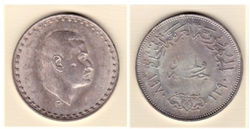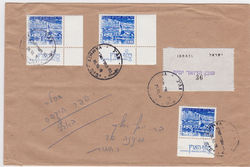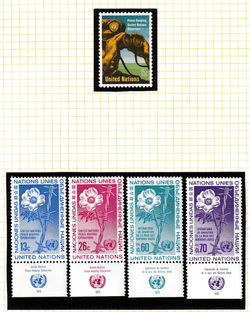top of page
Peaces
Peace has eluded the region for all of the years of Israel's existence - and even before. The 1948 war ended in Armistices, signed by Israel with Egypt, Lebanon, Jordan and Syria. That is, they agreed to stop fighting for a time. There was no talk of peace. Israel's comprehensive victory in the Six Day War led her to think that a peace settlement would be forthcoming. Instead, there came the Khartoum Declaration of 'The Three NOs'. The leaders of thirteen Arab states gathered at a summit conference in Khartoum, Sudan in August 1967 and pledged to continue their struggle against Israel. Their conditions were quite specific: NO peace with Israel, NO negotiations with Israel, NO recognition of Israel, and 'maintenance of the rights of the Palestinian people in their nation.'
The UN Security Council adopted resolution 242 that November, which called for 1) withdrawal of Israeli forces from recently occupied territories and 2) peaceful recognition of all states in the region (meaning Israel). It took decades for various Arab entities to accept that resolution, at least in theory. In the 1980s, the PLO expressed interest in a 'Two State Solution' opening the way for Israeli-Palestinian negotiations. Egypt and Jordan eventually made peace. Syria is not likely to make peace without regaining the Golan Heights, which Israel finds threatening. Lebanon is in the clutches of Hezbollah. Peace is coming in pieces.
 Peace ButtonsThis button expresses the wish for peace in Arabic, Hebrew, and English. |  Peace ButtonsIf only it were so easy. |  Gamal Abdel NasserNasser had been president of Egypt since he overthrew the Monarchy in the 1950s. Refusing to concede defeat in 1967, he stated 'We shall never surrender and shall not accept any peace that means surrender." Under his influence the Khartoum conference came up with the "three NOs" to any cooperation with Israel. Nasser died in 1970 and was succeeded by Anwar Sadat. |
|---|---|---|
 Sadat in JerusalemAnwar el-Sadat succeeded Nasser as Egypt's president in 1970. He led the Yom Kippur War to regain the Sinai Peninsula. Afterwards, he moved closer to the USA in diplomacy and decided to make peace. He thus became the first Arab leader to officially visit Israel. His historic visit to Israel and speech before the Knesset, in 1977, led to peace with Israel 2 years later. He appears on this button with Menachem Begin, then prime minister of Israel. |  Sadat Jerusalem medalsDue to some initial Egyptian successes in the Yom Kippur War, Sadat's prestige greatly increased. He moved towards the West in the face of unrest at home and Syrian pressure. His visit to Jerusalem was calculated to win support from the United States. |  Camp David 1978Begin and Sadat were invited by US president Jimmy Carter to Camp David, a presidential retreat in Maryland. From September 5 through 17, 1978 their two teams hammered out the Camp David Accords, which provided a framework for peace. Reportedly, President Carter's tenacious mediation is what kept the negotiations on track to a successful conclusion. |
 Peace terms Egypt & IsraelOn 26 March 1979 the actual peace treaty was signed. Sadat & Begin shared the Nobel Peace prize. Although the agreements provided for Israeli withdrawal from Sinai & parts of the West Bank, it did not include the PLO in the process, and so was condemned by Arab countries, & also the UN! Sadat was assassinated in 1981 at a 'victory parade' by Islamic Jihad. But it led the way for future agreements. This is the Hebrew version of the Peace treaty, which was signed in Arabic, Hebrew & English. |  Egypt Peace coinIn 1980, Egypt issued this one Pound silver coin to commemorate the peace treaty of the year before. It shows Sadat's profile and a hand holding a quill which morphs into an olive branch. The thumb of the hand is the head of a dove. |  Sadat DayOn 9 August 1981, Anwar Sadat and his wife Jihan flew from Washington DC to Plains, Georgia for a visit with President and Mrs. Carter. In a brief ceremony, Sadat described Carter as his 'Deep friend who risked so much for peace'. Carter called for full autonomy for Palestinians and recognition of Israel. However Carter's relationship with Menachem Begin was much more adversarial. This button was issued to celebrate the occasion. |
 Yammit.Sinai townAfter the 6 Day War, there were new areas to develop. Yamit was founded on sand dunes in northern Sinai near Gaza. Through irrigation, a variety of cash crops were raised, including flowers, citrus, grapevines and vegetables. By 1977, Yamit was a growing town of 2,000, as can be seen in this postcard from there. |  Yamit mailThis envelope was mailed at Yammit, addressed to Rechovot. It is postmarked 26 October 1978. Many had hoped this cluster of settlements would remain but the peace accords ruled that out. There was resistance to evacuation but by 26 April 1982, all the buildings were demolished and the last Israelis had left. All of Sinai was in Egyptian hands. |  Yamit.Moshav SadotBeside Yammit, there were a dozen other kibbutzim and moshavim with another 2000 settlers. One was called Moshav Sadot, to which this letter was addressed in 1980?. It had 70 families and a population of over 350. This letter was returned to sender. |
 Suez ships stranded15 ships were sailing in the Suez Canal when the 6 day war broke out. Egypt blocked the canal at both ends, with sunken ships and mines. Trapped crews developed a camaraderie and organized shared games and entertainment. Some created homemade stamps which Egypt accepted for postage. This envelope was stamped by 13 of the ships and mailed in August 1969 on board the Polish 'Boleslaw Bierut'. They were all freed when the canal re-opened in May 1975. |  Suez open.after peace 1979The Suez Canal, a vital link between the Mediterranean Sea and the Red Sea (and thus the Indian Ocean) had been closed to Israeli shipping since 1949. When Israel took control of the Sinai, Egypt blockaded the canal to all ships, until 1975. In 1979, as part of the Peace agreement with Egypt, Israel was allowed to sail through the canal. This envelope marks that occasion. |  Peace Now movementPeace Now is a non-governmental organization that advocates a two-state solution to the conflict. It started among IDF soldiers in 1978 when talks with Egypt seemed to falter. It has organized large demonstration in Israel, sometimes attracting right-wing violence. Their Settlement Watch project monitors Israeli activity in the West Bank, viewing settlement construction as an obstacle to peace. They receive funding from foreign states and organizations. |
 Oslo Accords 1993Secret meetings in Oslo, Norway led to a formal agreement for peace between Israel and the PLO. It provided for Israeli withdrawal from parts of Gaza and parts of the West Bank, and for Palestinian self-government in the form of the Palestine Authority. Arafat recognized Israel and pledged to reject violence. President Bill Clinton shepherded the agreement, signed on the White House lawn 13 September 1993. |  Oslo Leads to NobelIn 1994 Israeli Prime Minister Yitzhak Rabin, Israeli Foreign Minister Shimon Peres, and PLO Chairman Yasser Arafat received the Nobel Peace Prize following the signing of the Oslo Accords, "for their efforts to create peace in the Middle East". Such peace has yet to materialize. The Palestinian Authority issued souvenir stamps to mark the event. Shown are PA leader Arafat, Prime Minister Rabin, and US president Bill Clinton. |  Wye River MemorandumThere were subsequent meetings and agreements. A Gaza-Jericho agreement in 1994, Oslo II in 1995, and The Wye Memorandom in 1998. this last, signed in Maryland was meant to further implementation of previous agreements, including Israeli withdrawal. The Knesset approved it & most Israelis favored it but right wing opposition fueled by Arab violence led to new elections in Israel and Ehud Barak became Prime Minister. This 'Sport Card' commemorates the agreement. |
 Palestinian Authority StampsThe P.A. wanted to demonstrate its autonomy by having its own postal service. Israel agreed that the PA could issue stamps bearing their name - but for use only within the territory they controlled - that is Jericho and Gaza. This souvenir first day envelope shows the stamp, bearing the Palestinian flag, and also the Dome of the Rock in Jerusalem, which they did not control at all but which symbolized their hopes to have a capital there with that holy place. |  PA Actual mailThis envelope was actually mailed within the Palestine Authority. It was sent, registered, from Beit Lahia - a city in northern Gaza - to Rafah, a city and refugee camp at the southern edge of the Gaza strip. It is marked 'Return to Sender', 'Addressee Unknown'. |  Peace Buttons.Land for PeaceThese buttons, with Israeli and Palestinian flags, support the 'Two State Solution'. That is an outgrowth of UN resolution #242 which expects Israel to withdraw from 'occupied land' and Palestinians to peacefully recognize Israel as a legitimate state in its own territory. |
 Peace for PeaceA more right-wing approach is this slogan - 'Peace for Peace'. It recognizes that Land for Peace amounts to giving up strategic defensive depth of territory in exchange for promises of recognition, which may only be lip service. Instead, they call for peace all around first, with other decisions to be made in a less hostile climate. That is the right-wing Likud party position. |  Peace with JordanIn 1988, Jordan gave up any claim to the West Bank. In 1993 President Clinton pressured and induced King Hussein of Jordan to make peace with Israel. Discussions led to a Peace Treaty signed on 26 October 1994, on the border between the 2 countries. Israel acknowledged Jordan's 'special status' regarding the Jerusalem Holy Places. Here is the famous photo with P.M. Rabin shaking King Hussein's hand. |  Peace with Jordan CommemoratedThis souvenir envelope bears an Israeli stamp picturing Peace as a road sign, in 3 languages. There are two souvenir cancellations. The one on the right mentions the peace treaty of 1994 and shows a Jewish star becoming a dove of peace. The left one announces President Clinton's visit, on the occasion of the peace treaty. |
 Syrian Border.UNDOFRight after the cease-fire of the Yom Kippur War, a UN force was placed on the Golan Heights between Israel and Syria, to prevent clashes. UNDOF is the United Nations Disengagement Observer Force. Its initial forces came from Austria, Peru, Canada, & Poland. This envelope was mailed in 1989 through the Austrian unit, so it bears Austrian stamps. AUSBATT in the cancellation is the Austrian battalion. Forces are still there, sometimes at risk from the more recent civil war. No peace with Syria. |  UN stamps.observersIn 1966 and again in 1976, the United nations issued these stamps to honor the UN observer forces in the Middle East. UN stamps are only valid for postage when mailed AT the UN. However they are popular with collectors. |  20a.Arafat and Rabin stamp |
bottom of page